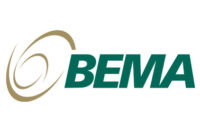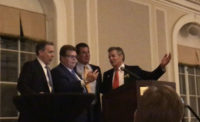The Annual Industry Review
By Renee M. Covino
What’s Up — And Down In the Candy Universe
Sure, there are new challenges in the candy industry
— especially now that it competes against all snacks — but
there’s still opportunity to address new consumer needs with the
sweetest products of all.
The investor community loves the confectionery category —
but what’s not to love?
At the recent National Confectioners Association (NCA)
State of the Industry conference, Andrew Lazar, managing director at Lehman
Brothers, named more than a handful of reasons why the confectionery
category is attractive — from both a retail and investor perspective.
They include the following.
Inspires impulse consumption. The percentage of consumers purchasing front-end display products
in any given month is highest for confectionery.
Expandable snacking occasions. This is vs. items with finite, definable usage occasions
such as toothpaste or shampoo. While this was always the case, “the
difference is, retailers now get it,” says Lazar.
Affordability. A
whopping 79 percent of snacks sold in the food/drug/mass/convenience
channels cost less than $1, and 35 percent are single-serve products.
Superior pricing power. Candy
is not locked in only to supermarkets; in fact, traditional grocery stores
represented just 20 percent of confectionery sales in 2005. Also, private
label has a low-single digit share of the confectionery category, compared
to 16 percent on average for packaged food overall.
Customers and consumers responsive to innovation. Limited
editions are just one recent example of innovation.
Concentrated and rational competitive dynamics. “Though many companies compete in the
confectionery category, the combined share of about 45 percent for the two
largest players (Hershey and Masterfoods) suggests that competitive
behavior is likely to be more rational,” says Lazar.
While this is all positive, viewing confectionery as
an advantaged category is not new news. Other influences, both good and
bad, have put new dynamics into place for the market, which is still
predicted to come out on top.
Sugar-free candy still dandy
By all superficial appearances, the sugar-free candy
segment is waning. Data from IRI and ACNielsen show the category reached
record highs in 2004, thanks mostly to the short-lived success of low-carb
chocolate confections, but that does not mean it is on a downward spiral
now.
| 2005 Confectionery Retail Sales | ||||
| Segment | $ Retail Value (in billions) | $ Manufacturer Sales (in billions) | % Change | |
| Chocolate | 15.7 | 10.2 | 2.0 | |
| Non-chocolate | 8.7 | 5.7 | 0.9 | |
| Gum | 3.5 | 2.3 | 4.1 | |
| TOTAL | 27.9 | 18.2 | 1.8 | |
| Source: National Confectioners Association estimates based on 2005 U.S. Dept. of Commerce 311D report and NCA Monthly Shipment Reports | ||||
“If you look at the latest 52-week numbers from
IRI through Feb. 19, 2006, diet chocolate candy is down 43.6
percent,” maintains Jim Corcoran, vice president of trade relations
for the NCA. “But non-chocolate is up 13.9 percent, and sugarless gum
is up 6.1 percent. So basically, we’re seeing a shift,” he
says.
While no one argues that sugar-free and low-carb
chocolate items declined rapidly after their first year of introduction,
the sugar-free non-chocolate sector continues to grow. “It’s
not growing at the same pace as it did a year ago, but it’s coming
off a bigger base now,” reasons Corcoran. “But much of the
action in sugar-free continues in the non-chocolate arena, and,
what’s more, the target audience for that is growing
tremendously,” he adds.
Prized premium chocolate
It didn’t exactly take confectionery by surprise
thanks to all the health-related news, but premium chocolate, defined
loosely by the industry as that which is more than $8 a pound, has risen to
the top of chocolate demand, even, or should it be said, especially, in the
mass channel.
| Mixed Bag for Chocolate Sales | |||||
| (Total confectionery sales for 52 weeks ending Dec. 25, 2005; supermarkets, drugstores and mass merchandisers, excluding Wal-Mart) | |||||
| Product category | $ Sales (in mil.) | % Change (vs. prior year) | Unit Sales (in mil.) | % Change (vs. prior year) | |
| Chocolate candy (less than 3.5 oz.) | 819.0 | 3.30 | 1,598.3 | -1.52 | |
| Chocolate candy (boxes and bags equal to or greater than 3.5 oz.) | 1,634.7 | 11.30 | 798.6 | 17.26 | |
| Chocolate candy (snack size) | 527.5 | -12.42 | 248.6 | -18.87 | |
| Chocolate gift boxes | 238.9 | -1.69 | 57.6 | 1.59 | |
| Novelty chocolate | 11.0 | -12.86 | 7.0 | 30.68 | |
| Sugar-free diet chocolate | 139.9 | -41.74 | 85.5 | -44.14 | |
| TOTAL CHOCOLATE | 4,452.5 | -0.21 | 3,391.9 | -1.14 | |
| Hard sugar candy/package & roll | 260.9 | -8.27 | 192.6 | -8.78 | |
| Chewy candy | 656.1 | .96 | 575.6 | -0.61 | |
| Novelty candy | 240.8 | -9.10 | 241.4 | -4.29 | |
| Licorice | 161.8 | 5.79 | 111.8 | 6.17 | |
| Nut/coconut candy | 66.5 | -7.15 | 70.6 | -8.44 | |
| Plain mints | 111.2 | -6.94 | 84.0 | -8.04 | |
| Breath fresheners | 306.6 | -3.14 | 222.7 | -6.92 | |
| Caramel/taffy apples/kits/dips | 53.9 | -6.16 | 26.5 | -10.37 | |
| Diet candy | 81.8 | 17.35 | 54.7 | 17.52 | |
| TOTAL NON-CHOCOLATE CANDY | 2,291.0 | -1.17 | 1,851.4 | -3.30 | |
| Regular gum | 295.5 | -1.31 | 444.9 | -2.40 | |
| Sugarless gum | 756.0 | 6.48 | 693.9 | 4.76 | |
| TOTAL GUM | 1,051.6 | 4.17 | 1,027.8 | 2.32 | |
| Breakfast/cereal bars | 543.7 | 5.60 | 198.13 | 5.96 | |
| Granola bars | 618.1 | 12.06 | 258.2 | 10.80 | |
| Nutritional/health | 524.5 | -10.39 | 326.2 | -6.28 | |
| All other snack bars | 20.4 | 8.04 | 7.79 | 12.58 | |
| Rice squares | 121.0 | 27.43 | 52.6 | 32.49 | |
| TOTAL SNACK/GRANOLA BARS | 1,827.8 | 3.52 | 843.0 | 3.47 | |
| OTHER | |||||
| Cough/sore throat drops | 393.1 | 11.17 | 210.2 | 5.49 | |
| Marshmallows | 131.1 | 2.88 | 108.5 | 0.83 | |
| Carob/yogurt-coated snacks | 22.5 | 21.85 | 9.0 | 14.54 | |
| Chocolate-covered salted snack | 22.8 | 37.54 | 9.7 | 38.12 | |
| Fruit rolls/bars/snacks | 524.0 | -2.24 | 288.2 | 1.58 | |
| Source: Information Resources, Inc. | |||||
Combined, Dove, Ferrero, Ghirardelli, Hershey Dark,
Lindt, Mon Cheri and Perugina grew 32.2 percent for the period ending Dec.
25, 2005, according to NCA and IRI data.
“Some might make an argument that Hershey Dark
and Dove don’t constitute gourmet chocolate, but if we took them out,
that percentage would be even higher,” maintains Corcoran. The top
three reason why gourmet chocolate sales are growing, according to the NCA
— “all the good news surrounding dark chocolate and
antioxidants, they’re sexy, and the big commitment at retail,”
Corcoran explains.
Good seasonal dates
Generally speaking, “Halloween and Christmas
candy did well in 2005, Valentine’s Day and Easter did not,”
according to Corcoran. But that was last year — when seasonal dates
were not as favorable overall as they are for 2006. Thus, the NCA is
predicting a 2.3 percent increase in seasonal confectionery sales this
year.
Valentine’s Day this year fell on a Tuesday,
which is classified as good in seasonal candy terms, and “early
indications are that Valentine’s Day got off to a positive
start,” Corcoran maintains. It appears that for the four weeks ending
Feb. 19, 2006, chocolate candy sales were up 3.1 percent.
Easter this year is late (April 16), allowing for more
shopping days; Thanksgiving is early, giving more shopping days to
Christmas (32). Halloween, falling on a Tuesday, is the only
“downer” date, but “the trend on Halloween candy is so
good, it makes the Tuesday date really neutral to sales,” believes
Corcoran.
Besides the day/date of the holiday, other factors
affecting seasonal candy sales include the economy, consumer confidence,
consumer mood, shopping patterns, and merchandising strength/visibility.
Retail landscape changing
When last year’s prime Christmas selling season
is studied, the convenience and drug sector did “extremely
well” in candy sales, according to Corcoran, while the mass and food
sectors “struggled.”
| Changing U.S. Population by Age | ||
| Segment | Shift 2000 - 2010 | |
| Total U.S. | +11.0% | |
| 5 - 9 | -2.1% | |
| 10 - 14 | Even | |
| 15 - 24 | +6.5% | |
| 25 - 49 | -2.0% | |
| 50 - 64 | +39.0% | |
| 65 - 74 | +16.0% | |
| 75+ | +13.0% | |
| Changing U.S. Population by Race | ||
| Segment | Shift 2000 - 2010 | |
| Total U.S. | +11.0% | |
| White-Non-Hispanic | +2.7% | |
| Black | +12.0% | |
| Hispanic | +40.0% | |
| Asian | +36.0% | |
| SOURCE: U.S. CENSUS BUREAU | ||
Most likely, this and other candy sales fluctuations
are due to the extreme blurring of the channels and the fact that the
“value channels” are grabbing more shopping trips at the
expense of the food and mass sectors, according to a March, 2006 report by
ACNielsen, “Channel Blurring and Consumer Trends.”
“The grocery channel has a significant advantage
over other channels in terms of shopping frequency. However, as seen in
prior years, shopping frequency within this channel is on the decline; in
2005, the average household made 64 trips to the grocery channel —
eight fewer trips vs. 2001,” states Todd Hale, senior vice president
of consumer and shopper insights.
“With conversion of some mass stores to
supercenters and the closure of certain mass chains, shopping frequency
within the mass channel is also on the decline,” Hale continues.
“Although new store openings may be holding down shopping frequency
in supercenters, average shopping frequency within this channel is
relatively low, but growing nicely. This may also be driven by the distance
with which rural shoppers must travel to shop in Wal-Mart
supercenters.”
Shopping frequency in the other channels (drug,
convenience) remained fairly stable over the past three years, but dollar
stores are showing trip growth, according to the report.
U.S. population shifting
Currently the “baby boomlet” generation is
in the 15-24 age range, which is swelling, according to the U.S. Census
Bureau. But below that, kids ages 0-14 are in decline, as compared to
years’ past. How will this affect candy sales?
“Non-chocolate novelty candy won’t be what
it once was,” says Corcoran. “When I first joined the NCA 10
years ago, that was an automatic growth category because the baby boomlet
kids were 10-15, which is the prime target for novelty. Now, its target
audience is not growing, so times will be more difficult for that
category,” he says.
Meanwhile, the population will become more ethnically
diverse, giving way to even “spicier,” more
“ethnic-oriented” treats.
Business costs up
Even without considering the domestic sugar shortages,
“the structural cost of doing business is rising, which puts a
premium on productivity efforts and value-added innovation,” says
Lazar. Thus, CPG manufacturers from all walks, including candy, are now
facing increased margin pressure from rising costs, both transitory (cost
for inputs which include commodities and energy/packaging) and structural
(with the fragmentation of media and a more demanding consumer, costs of
R&D and marketing are also rising). “Such costs are likely to
remain at elevated levels,” maintains Lazar. n
Sugar Situation STAYS SOUR
Despite periodic modest increases in sugar import
quotas, the impact of last year's hurricanes and several other factors are
expected to keep sugar in short supply for U.S. candy makers in the months
ahead.
Domestic sugar supplies took a major hit as a result
of last fall's hurricanes, which devastated cane crops in Louisiana and
resulted in sugar refinery closings. Also contributing to the shortage was
increased demand for sugar as the low-carb craze faded and earlier adverse
weather conditions that compromised beet sugar production.
Current sugar prices are about 50 percent higher than
normal, reports Thomas Earley, executive vice president of Promar
International, Alexandria, Va., and an economist for the National
Confectioners Association. Earley estimates that confectionery
manufacturers' sugar costs will be up in the range of $200 million to $300
million, reaching a total of $1 billion for 2006.
The increases are "cutting into [candy
manufacturers'] operations budgets tremendously," says Melane Rose,
NCA vice president of government affairs. "With an ingredient this
key, and a price increase this great, of course, you will see bottom lines
affected," she adds.
Although it varies from category to category, sugar
represents approximately one-seventh of materials and packaging costs for
confectionery products, according to Earley.
"USDA is now estimating that ending stocks [of
sugar] this year will be 1.5 million tons, which is a stock/use ratio of
14.4 percent, which is below where it needs to be to have reasonable
prices," says Earley. Current sugar prices are the highest in 25
years, Earley adds.
Legislative Debate
Don’t let the fact that this map shows a mere 17
states with pending nutrition/obesity bills this year — affecting the
sale of candy in schools — fool you. “We’re still
relatively early in the legislative sessions, so it may be misleading; it
doesn’t look that bad now, but we expect it to get a lot worse in the
coming months,” says Stephen Lodge, vice president of state
government affairs for the NCA.
Last year, 232 bills in 44 states were proposed,
according to Lodge. While most of them did not get passed, some of them did
(such as one signed by Governor Schwarzenegger in California), and Lodge
expects that more legislators will propose them again this year.
“It’s not a way to solve the obesity problem, but a lot of them
want to try and do something,” he says.
In California, for instance, there is now a ban on any
food item sold in schools with 35 percent or more of saturated fat and 30
percent or more of sugar by weight. “That pretty much takes candy out
of the equation,” says Lodge.
North Carolina and Louisiana also passed
“candy/school vend” bills last year — but only 50 percent
of food items had to meet the standards. “That’s a lot better
than a total restriction or ban,” states Lodge. “It gives more
flexibility to the school, especially those with higher grades that make
money on the sale of candy for band and sports.” It’s not that
the NCA actually supports such “percentage” bills, but
“we don’t oppose them the way we oppose California,”
Lodge adds.





